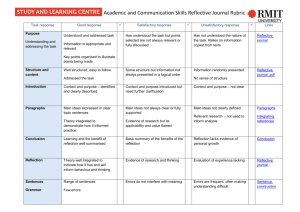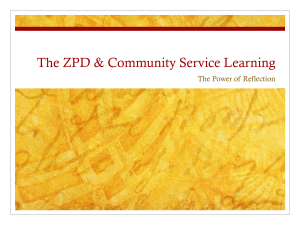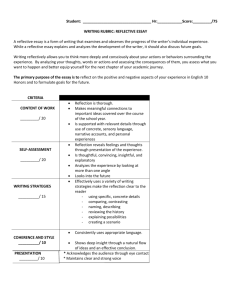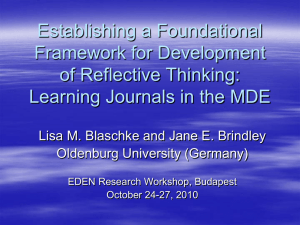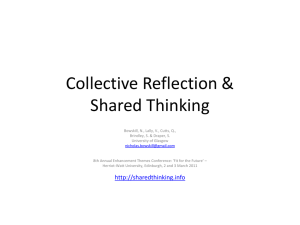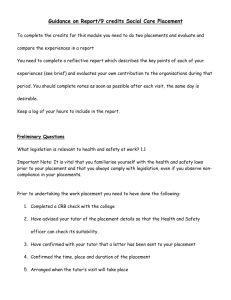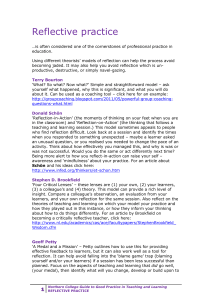A Report on The Assessment of Reflective Practice
advertisement
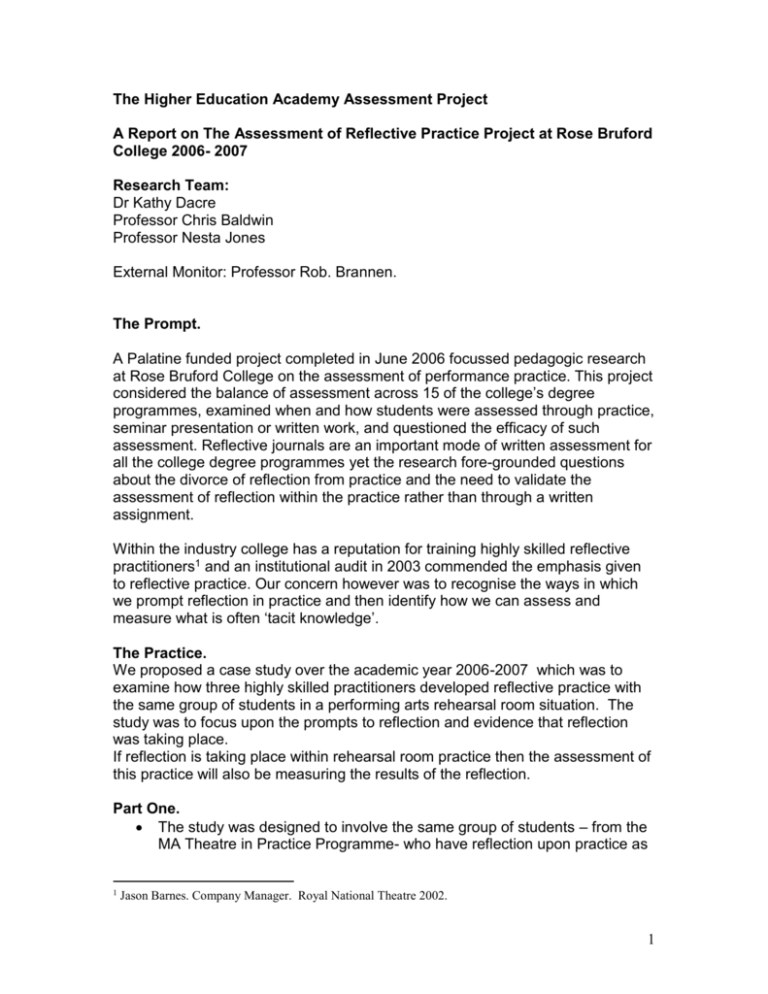
The Higher Education Academy Assessment Project A Report on The Assessment of Reflective Practice Project at Rose Bruford College 2006- 2007 Research Team: Dr Kathy Dacre Professor Chris Baldwin Professor Nesta Jones External Monitor: Professor Rob. Brannen. The Prompt. A Palatine funded project completed in June 2006 focussed pedagogic research at Rose Bruford College on the assessment of performance practice. This project considered the balance of assessment across 15 of the college’s degree programmes, examined when and how students were assessed through practice, seminar presentation or written work, and questioned the efficacy of such assessment. Reflective journals are an important mode of written assessment for all the college degree programmes yet the research fore-grounded questions about the divorce of reflection from practice and the need to validate the assessment of reflection within the practice rather than through a written assignment. Within the industry college has a reputation for training highly skilled reflective practitioners1 and an institutional audit in 2003 commended the emphasis given to reflective practice. Our concern however was to recognise the ways in which we prompt reflection in practice and then identify how we can assess and measure what is often ‘tacit knowledge’. The Practice. We proposed a case study over the academic year 2006-2007 which was to examine how three highly skilled practitioners developed reflective practice with the same group of students in a performing arts rehearsal room situation. The study was to focus upon the prompts to reflection and evidence that reflection was taking place. If reflection is taking place within rehearsal room practice then the assessment of this practice will also be measuring the results of the reflection. Part One. The study was designed to involve the same group of students – from the MA Theatre in Practice Programme- who have reflection upon practice as 1 Jason Barnes. Company Manager. Royal National Theatre 2002. 1 a major aspect of their course. They worked with each practitioner for at least five days. Their work was video recorded and a researcher-observer took specific notes on prompts to and evidence of reflection. The practitioners who were a part of this research included: Chrissie Poulter, Senior Lecturer in Theatre practice at Trinity College, Dublin. Director of Arts lab (Ireland). Chris Baldwin, Visiting Professor at Rose Bruford College. Director of Spiral Theatre (Spain) Chris Goode, Visiting Lecturer at Sussex University & Central School of Speech & Drama. Director Camden People’s Theatre 2001-2004. Currently working with Exit Strategy, recipients of an Arts Council Artists’ Bursary. Part Two. Six theatre directors who have worked with major professional companies gave specific examples of how they prompt reflection in rehearsal. The Report. An introduction to the learning mode of the rehearsal room. It became obvious to the research team that in order to identify rehearsal room practice as a model of learning which involved reflection upon practice it was essential to identify and value the kind of knowledge that was being transferred within the rehearsal space. This knowledge may be largely intuitive and an introduction to intuitive knowledge seemed essential to an understanding of the material involved in our case study. This introduction places our work in the context of research on intuitive learning which, in the rehearsal room, combines with the acquisition of the craft skills of acting. “Craft gives you a kind of control and intuition is about letting go.” “Craft is containment and intuition is about spillage, the unexpected”2 The current recognition of intuition and creativity as elements in knowledge acquisition however should be seen against years of disregard: The distrust of intuition, and the inability to see how (and, even, perhaps, why) it could be incorporated into education, reflect 300 years of European cultural history. The Cartesian slogan “Cogito ergo 2 Bannerman. C,Sofser.J,&Watt.J.(2006) Navigating the unknown. The Creative Process in the Performing Arts. Middlesex U.P. 2 sum” encapsulated the successful attempt to reduce the human mind only to its most conscious and rational regions, and to persuade people that their fundamental identity resided in the exercise of this explicit, articulate, analytical form of intelligence. The Enlightenment of the eighteenth century picked out just this single way of knowing and, in raising it to a high art, implicitly ignored or disabled any others: those that were not so clinical or cognitive, and were instead more bodily, sensory, affective mythic or aesthetic – in a word, intuitive. 3 Different Kinds of Knowledge: Explicit, Implicit and Tacit and Intuitive Knowledge We can define Explicit Knowledge as knowledge that has been articulated and, more often than not, captured in the form of text, tables, data, diagrams, and so on. Explicit knowledge is scientifically proven or demonstrated, supported by empirical (albeit provisional) evidence. Other examples of explicit knowledge include documented best practices, formalized standards and methods of assessment which are measured against benchmarks. Implicit Knowledge, on the other hand, is knowledge that can be articulated but has not been so far. Its existence is implied by or inferred from observable behaviour or performance. This is the kind of knowledge that can often be teased out by a teacher and, as the video evidence seems to suggest, is often done so with a high dependence on metaphor and story telling within learning contexts. There is a third category of knowledge, Tacit Knowledge, that cannot be articulated yet is crucial in creative and innovation led environments. It describes the phenomenon that, “we know more than we can tell" (Polanyi 1967). Tacit Knowledge cannot be articulated in the same way as explicit knowledge and can only be gained through training and personal exposure and experience. Furthermore such knowledge is often deeply embedded and specific to a given culture. If one is not immersed in a particular culture (geographic, social or job related) such tacit knowledge remains inaccessible. For this reason theatre training has often depended heavily on contact with professional practitioners – as only they have the tacit knowledge which is embedded in their practice even if it is not always easily shared with students. The academic-isation of theatre training and studies does, in this sense, pose a difficulty. While academics are highly competent producers and assessors of explicit knowledge their tacit knowledge base is bound to be a reflection of their education practice and more limited as far as professional theatre is concerned. A thirty year career in a drama department is not the same as a thirty year career in professional theatre. So as teachers we need to guard against the danger of reducing the value given (1) Claxton, G. “The anatomy of intuition”, (Pages 32 to 52) Atkinson,T & Claxton, G. (2004) The Intuitive Practioner, Maidenhead, OUP 3 3 to the very kind of knowledge which makes theatre and performance training possible in the first place. Intuitive Knowledge While the concept of Tacit Knowledge began to be articulated in the 1960´s in America and Japan , intuition has a longer history of theoretical consideration in philosophy, psychology and pedagogy (Westcott 1968). Henri Bergson (1859-1941) defined intuition as, the ability of an artist to place himself within an object so as to coincide with what is unique in that object and consequently inexpressible (Westcott 1968) On a more concrete note the Chambers´ Twentieth- Century Dictionary defines intuition as, the power of understanding or realizing something without conscious rational thought or analysis. This definition, while clearly useful and less mystical than Bergson´s, may still contain a number of more specific practices which are worth examining. This is particularly the case when examining how teachers of performance can promote or suppress reflective practice within the rehearsal/class room through their pedagogic strategies. Strategies which may seek an impossible articulation in the language of words. Expertise. On many occasions, “the unreflective mastery of complex but familiar domains”4 (see also Dreyfus and Dreyfus 1986) is what we refer to as expertise. In many instances however it is striking how many virtuoso teachers, artists or directors are often unable to articulate the basis of their skill. There is often a disparity between what a director/teacher can do and the ability to articulate it – something which should be of concern to teachers of performance especially when standardisation and explicit (if not false) knowledge is used as a means to fill this perceived gap in assessment and reflective methodologies. Learning through intuition. The partial incommensurability of expert know-how and explicit knowledge means that learning, as well as fluent performance itself, may need to proceed, to an extent, intuitively. 5 Maxims are rules, the correct application of which is part of the art which they govern…Maxims cannot be understood, still less applied, by anyone not already possessing a good practice knowledge of the art (Polanyi 1958) Learning which takes place in the rehearsal room is often occurring within an ambiance of ambiguous directions from the teacher and a linguistic environment heavy saturated 4 5 ibid ibid 4 with maxims, metaphors and hunches. Clearly such an environment often leads to a state of confusion and flux. Yet if students simply relax, try not to rationalise or figure out what is going on they often come to understand, master even, a given technique or skill at an intuitive level. Such a process is often associated with characteristics of pedagogy and chaos 6. But working at such a level often enable students to master a given task more rapidly than those searching for conscious assimilation and comprehension. In his essay The anatomy of intuition7 Claxton identifies six varieties of intuition. Such classification should enable the researcher into pedagogy and reflective learning within the rehearsal room to considerably extend the intellectual framework being applied in such contexts. In the essay Claxton lists, Expertise – the unreflective rumination of intricate skilled performance; Implicit Learning - the acquisition of such expertise by non-conscious or non conceptual means; Judgement - making accurate decisions and categorizations without, at the time, being able or justify them; Sensitivity – a heightened attentiveness, both conscious and non-conscious, to details of a situation; Creativity – the use of incubation and reverie to enhance problem solving; and Rumination – the process of “chewing the cud” of experience in order to extract its meaning and its implications All of these forms of intuition can be identified as existing, at one time or another, within the examples of classroom practice accompanying this report. Describing the Data. As we observed the reflective learning in the practical work observed for the project we realised that we were seeing the acquisition of tacit knowledge through modes of reflective learning that had been defined by educational theorists in different ways. We decided to use their definitions – set out below- to categorize and describe what we observed. Reflective Practice as Transformative Learning: takes place through developing a student actor’s critical ability in a process which brings about critical transformation when we expect student actors not just to be skilled acolytes but challenge them to use conceptual ability and self awareness8 6 Baldwin,C. “Teatro De Creación - Caos, dirección y amor son los tres ejes sobre los que pivota un trabajo creativo” Diagonal No. 27 30th March 2006 7 Claxton, G.“The anatomy of intuition”, (Pages 32 to 52) Atkinson,T & Claxton G (2004) The Intuitive Practioner, Maidenhead, OUP 8 Harvey,l &Knight,P (1996) Transforming Higher Education. Buckingham: SRHE/OUP 5 Reflective Practice as a Critical Business: Reflection and critical evaluation have to contain moments of imaginary alternatives. Reflexivity has to offer resources for continuing development. Reflexivity, critique and imagination have to be accompanied by personal capacities for change and for critical but constructive action 9 Reflection in Action: Rethinking of some part of our knowing- in- action leads to on the spot experiment and further thinking that effects what we do in the situation in hand. We restructure strategies of action.10 Five Dimensions of Reflection within Practice set out by Donald Schon. 5. reflection on the reflection on action 4. reflection on the description of the reflection- in- action 3. description of the reflection-in-action 2. reflection-in-action 1. action11 Explicit knowledge, Tacit Knowledge & Implicit Knowledge as defined in the introduction. The practical rehearsal room work was filmed and observed and the nature of the reflective practice that took place examined. Examples of the above categories of reflective learning were chosen and analysed as examples of reflective learning. A DVD of these examples has been made to accompany this report. The filmed work with Chrissie Poulter took place outdoors and although the practice fed into our research the visual & sound quality was too poor to include. The accompanying DVD shows the following examples of reflective practice. OBSERVING PRACTICE. Example One: 9 10 Reflection in Action. Tutor: Chris Baldwin Rethinking of some part of our knowing- in- action leads to on the spot experiment and further thinking that effects what we do in the situation in hand. We restructure strategies of action. Barnett,R(1999) Higher Education: A Critical Business. Buckingham: SRHE/OUP Schon,D. (1987) Educating the Reflective Practitioner. London. Jossey-Bass 11 Described by Brockbank, A & McGill, I. (1998) Facilitating reflective Learning in Higher Education. Buckinghamshire:OUP.p78 6 Description: At the commencement of this extract the cohort is reflecting upon an extended task which has taken two days by this point. At the beginning of the task the tutor had invited each student to bring from home objects and photos which signified journeys each one had made in the last year or so on their way to college (a significant proportion of the students are mature or have come from abroad). During two days each student had told a story emanating from their object and photo. Then the group had made an instillation (seen in the video behind the students) using these objects and images. Woollen cord had then used to connect objects and photos in ways which “revealed connections between the journeys and stories described in the course of the process”. In this video extract the reflection process passes through various phases: For the first 2 minutes or so we see the students describing the nature of the connections and concepts revealed by the instillation. The tutor intervenes in order to focus on one particular intervention by a design student, Debbie, and reinforces the importance of her observation regarding the “special attention people had give to placing their objects”. Later in the workshop this point is returned to and new practical exercises developed by the tutor to examine this concept in a concrete context. The tutor also reinforces the importance of “intuition” for those in the workshop and as a “general rule” for all theatre makers. The tutor then goes on to define the nature of the next stage, firstly reinforcing the importance of, “intense listening and intense talking” as a means of reflection on action. The tutor reinforces the fact that his methodology is not fixed but related to a “searching” “edging” process which involves defining “stepping stones”. This in turn gives the students an opportunity to validate and trust a process which is clearly somewhat chaotic, unstructured and intuitive. After the tea break, the tutor begins by stating that, “we have been responding to something we have made”. He is not requiring students to theorise or reflect on a concept but on concrete examples of work (in this case an installation comprising of objects, images and wool). He reinforces the importance of “making, reflecting and remaking in the light of the reflection” “we are now going to remake - but on a higher level, a higher performative level”. He sets up the next concrete task which will lead the cohort to “a higher performative level”. Sub groups are given an hour to make a new performance which will later be reflected upon. 7 The second clip is taken from after the groups have been working together for an hour and shows one of the “performative outcome” of their rehearsal. This outcome is reflected upon immediately by the other half of the cohort. The tutor is using this methodology to encourage, devisers to use audience feedback (reception theory) to guide their subsequent rehearsals to deepen understandings of dramaturgy – in the example the theme becomes about the nature of contradiction in dramaturgy. Example Two: Reflection in Action. Tutor: Chris Goode Rethinking of some part of our knowing- in- action leads to on the spot experiment and further thinking that effects what we do in the situation in hand. We restructure strategies of action. Description: This extract begins with students performing a piece of work prepared over an hour of rehearsal using as a baseline the song, Boys, by David Bowie. We see two choreographed sections using the same song. After the performance the student observers immediately begin to explore the nature of piece, in particular how focus shifts and does not seem “balanced”. The tutor discusses how the eye follows action and how disequilibrium is created. Rapidly a series of ideas for the next level of rehearsal are agreed – with little intervention from the tutor. Randomness, patterns and rhythm, shifts in perspective are all discussed. The turor reinforces what he thinks “works and is interesting” but also gently gives his opnion as to what needs to be reconsidered. All this reflection is done in a spirit of excitement generated from those in the performance as well as by those observing the performance . Example Three: Reflective Practice as a Critical Business. Tutor: Chris Goode Reflection and critical evaluation have to contain moments of imaginary alternatives. Reflexivity has to offer resources for continuing development. 8 Reflexivity, critique and imagination have to be accompanied by personal capacities for change and for critical but constructive action Description: Section One consists of two prepared pieces which explore limited registers of language. In Section Two the teacher is reflecting with his group on the piece of practical work presented moments beforehand. Here we can see and hear him discuss how “language can constrain” the world of the play. This is picked up by a student who talks about another kind of language – silence. The teacher responds by proposing some new work regarding where, “silence borders on non performativity”. Thus we observe the teacher proposing imaginary alternatives, students responding positively if not tentatively, and this in turn being taken by the teacher and transformed into new action. Example Four: Reflective Practice as Transformative Learning. Tutor:Chris Baldwin takes place through developing a student actor’s critical ability in a process which brings about critical transformation when we expect student actors not just to be skilled acolytes but challenge them to use conceptual ability and self awareness Description: This session took place after two previous sessions (each lasting three hours) in which the nature of the image in theatre and performance was examined through practical exercises. In this 23 minute clip we see the teacher inviting the students to present their work from the previous session to the rest of the cohort. We can observe how, The students present a piece of performance and then repeat it. How this repetition becomes a pedagogical opportunity to encourage cohort observers to offer critical feedback to the performance group. How student performers, designers, writers, directors and technicians develop their conceptual ability in regards to visual transformations, visual stimuli and storytelling, object as a player in an evolving narrative and how rehearsal can enable us to focus on one matter (in this case “visual language”) while remaining conscious of the presence of another (in this case “narrative”) 9 Students can also be observed reflecting on past sessions and talking about how these impacted on their more recent experiences (“grab and apply”). Students can be seen and heard planning and identifying their next stage in the work. Example Five: Explicit/Tacit and Implicit Knowledge. Tutor: Chris Baldwin Explicit Knowledge is knowledge that has been articulated and, more often than not, captured in the form of text, tables, data, diagrams, and so on. Other examples of explicit knowledge include documented best practices, formalized standards… Tacit Knowledge is knowledge that cannot be articulated. “We know more than we can tell." Implicit Knowledge is knowledge that can be articulated but hasn’t (yet). Its existence is implied by or inferred from observable behaviour or performance. This is the kind of knowledge that can often be teased out by a teacher. Description: The group are invited to extend an earlier improvisation about “confinement versus chaos” by taking turns to enter a space defined by the presence of a chair. They are asked to describe the room they find themselves in (Section One of this video excerpt). The teacher then uses a technique (“collective memory boarding”) to give value to the implicit, half expressed, ideas and discoveries made in the first part of the exercise (Section Two) The teacher uses another sheet of paper to show how he might generate potential dramatic and narrative forms, linear and non linear, as well as thematic developments from this random material (Section Three) thus reinforcing the need and value of intuition or “not always knowing what we are looking for” In Section Four we can observe the group defining the nature of their emerging drama and defining how to achieve the first concrete steps for the next stage in the process. 10 Example Six: Explicit/Tacit and Implicit Knowledge. Tutor: Chris Goode Description: Here the teacher can be observed talking about the work generated by the students over the past few days. He describes how “two wings” are emerging – two sets of ideas and concepts, and how the relation between the two will be explored in the subsequent rehearsals. The director/tutor is thus giving value to a process which is not always explicit but rather tentative; it is searching and defining the phases of work as the process develops. However this process is built from a cyclical process; construction of performance, reflection and the further construction. Once again the tutor can be seen validating the importance of randomly generated material and see him moving from exploring the explicit to the implicit. Conclusions The observation of rehearsal room practice confirms that with careful structuring of the activity, constant monitoring of the situation and strategic prompting by the tutor reflective learning is able to take place in rehearsal room practice. The awareness of the tutor of the need to prompt the reflection in order to ascertain that it has been a part of the student learning process would seem to be paramount in justifying the assessment of rehearsal practice as reflective practice and the claim that all performance products are the result of a reflective process. In order to assess reflection it must be possible to identify when reflection in practice has happened and whether explicit, tacit or implicit knowledge has been transferred. The above categories of reflective learning were useful in identifying and analysing the work we observed and we would recommend them as useful categories to use when reflective moments are planned and incorporated into rehearsal room practice. If such moments are planned, developed and incorporated by the tutor into the rehearsal room practice then that practice is able to be assessed as reflective practice. 11 It appeared to the team that it might be helpful to the performance tutor to consider practice based reflection in the rehearsal room as a series of events within a journey which enable a student performer to move from Unconscious Incompetence to Conscious Incompetence and then to either Conscious Competence or Unconscious Competence. It also became clear that to a large extent these events or strategies could be planned, developed and applied again and again in performance practice. The final part of our research reinforced this idea. Talking to Directors. We interviewed six directors asking them to identify strategies or phrases that they constantly use as prompts to reflection in the professional rehearsal room. They found no difficulty in thinking of these “pet tricks” and all admitted that they applied them constantly in different rehearsal situations. Interestingly three of these involved the director stepping back and prompting the actors to reflect and make their own choices. Yvonne Brewster OBE (Talawa Theatre) in rehearsal in October 2007 constantly said to the actors “ I never tell actors what to do” prompting them to sift through the possible actions they might take. Iain Reekie ( 7.84) came up with a similar strategy telling his cast ‘if you’re entirely dependant on me for ideas in this process, we are lost!’ Colin Ellwood (RSC. Strangers Gallery) described at more length a similar process: My main thought is that when the actors have explored through a scene and engaged with it, I often try to ‘set a framework’ within which they can make their own assessment or have their own reflection. My feedback will often therefore (at this early stage)be vague or quite impressionistic and tangential, and offering just my response rather than an exact diagnosis. I almost work at being the incompetent amateur in the room, offering an accurate but partial and inexpert response which they can work with to solve their own problems – thereby (perhaps) owning the result, and perhaps coming to it instinctively rather than logically, and from the inside – and also of course taking responsibility for their own work. It’s a way of trying to ensure the actors see the challenges as theirs’ rather than the directors. I do a lot of wondering aloud, rather than direct questioning and asserting. They keep on playing rather than locking things down, until some solid stuff starts to emerge from the soup. And he offered a second idea. 12 Sometimes in my experience actors can get a bit down in the early stages of the work exploring a scene, and reflection is inhibited because they just write off all that they are doing. There’s a great Teresa of Avila idea that I often use for this – where she talks of, when writing, having to ‘expel the idiots from our houses’ - in other words write through the first – probably not very good – ideas until the genuine articles start to emerge. It works for acting too. Lou Stein ( Gate Theatre. Watford Palace Theatre) talked about not using words, "The non-verbal space between a director and an actor is often the best way to deepen an understanding between the two. A simple facial or body gesture and a few seconds of well-timed silence can sometimes give the actor the inspiration he or she needs." Whilst Annie Castledine (Derby Playhouse. Theatr Clywd) described how she will help actors respond to the shape they create in the rehearsal space by asking them to imagine they are on the rim of a saucer and they must balance the space in order to keep the saucer upright. It is notable that all these directors prompt the actors to make their own creative choices. David Thacker (Young Vic, RSC,BBC ) continued with this idea of prompting choice but told an anecdote of working with Arthur Miller. Miller told him to remember that all his characters were people that he knew in real life and that the actors working on his plays were to remember that. He illustrated this by describing the trip he was on with Miller when the latter suggested they make a detour to visit the Last Yankee, a character in the Miller play of this name. True to the play the “character” met Miller with a greeting that included deep complaints about his wife David said that he has, since then, always asked actors to think of the person the playwright has drawn rather than some version of themselves, although that is what they will eventually perform. These short examples taken from our discussions on reflective practice with directors do serve to emphasise that the tutor/director needs to be aware of the efficacy of such prompts to reflection both in enabling the student /actor to continue on the creative journey and in deepening the mode of learning taking place. Bibliography Atkinson,T & Claxton G (2004) The Intuitive Practioner, Maidenhead, OUP 13 Baldwin, C Stage Directing (2003) Crowood Baldwin ,C “Teatro de Creación; caos, dirección y amor son los tres ejes sobre los que pivota un trabajo creativo”in Diagonal No 27 March 2006 Barnett,R(1999) Higher Education: A Critical Business. Buckingham: SRHE/OUP Brohm, R. Bringing Polanyi onto the theatre stage: a study on Polanyi applied to Knowledge Management, in: Proceedings of the ISMICK Conference, Erasmus University, Rotterdam, The Netherlands, 1999, pp. 57-69 Brockbank, A & McGill, I. (1998) Facilitating Reflective Learning in Higher Education. Buckinghamshire:OUP. Chomsky, N. (1972). Language and Mind. San Diego, Harcourt Brace Jovanovich. Chomsky, N. (1980). Rules and Representations. New York, Columbia University Press. Chomsky, N. (1986). Knowledge of Language. New York, Praeger. Csikszentmihalyi, M. (1996). Creativity: flow and the psychology of discovery and invention. New York: Harper Collins Publishers. Dacre,K.&Mackey,S. Self-interpreting Animals: action research and the reflective drama journal. (1999) Research in Drama Education,Vol.4,No 1. Dretske, F. (1991). Explaining Behavior: Reasons in a World of Causes. Cambridge MA, MIT Press. Dreyfus, H.L and Dreyfus , S.E (1986) Mind over Machine: the Power of Human Intuition and Expertise in the Era of the Computer. Oxford, Blackwell Harvey,l &Knight,P (1996) Transforming Higher Education. Buckingham: SRHE/OUP Polanyi, M. (1958/1974). Personal Knowledge: Towards a Post- Critical Philosophy. Chicago, University of Chicago Press. Polanyi,M. (1983) The Tacit Dimension. MA: Peter Smith. Reber, A. (1995). Implicit Learning and Tacit Knowledge: An Essay on the Cognitive Unconscious. New York: Oxford University Press Rossatto, Ceser, A (2005) Engaging Paulo Freire´s Pedagogy of Possibility. Roman and Littlefield 14 Searle, J. (1992). The Rediscovery of the Mind. Cambridge, MA: MIT Press. Searle, J. (1995). The Construction of Social Reality. New York, Free Press. Schon,D. (1987) Educating the Reflective Practitioner. London. Jossey-Bass Schon.D. (1983) How Professionals Think in Action. New York. Basic Books Tsoukas, H. (2003) ‘Do we really understand tacit knowledge?’ in The Blackwell handbook of organizational learning and knowledge management. EasterbySmith and Lyles (eds), 411-427. Cambridge, MA: Blackwell Publishing Westcott, M. R.. (1968). Toward a Contemporary Psychology of Intuition. New York: Holt, Rinehart and Winston. . ] 15 16

